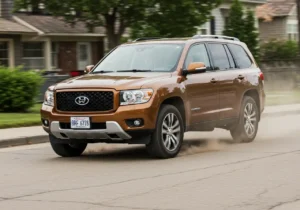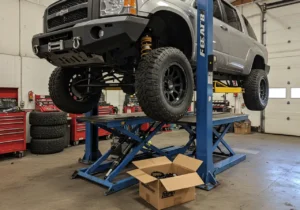Signs Your Suspension Needs an Upgrade—and the Best Solutions
The vehicle suspension system is an essential part of your vehicle that helps keep the braking and handling smooth. It manages various aspects such as bounce, acceleration, wheel alignment, power steering, drive, sway, and roll. Key components like springs, shock absorbers, ball joints, stabilizer bars, and others play a vital role in this system.
Why it matters: It’s important to know the signs of a worn-out suspension system so you can keep your vehicle running well and safely.
In this article, we’ll look at the signs that indicate your suspension might need an upgrade. This is especially important for off-road vehicles and those used for heavy towing. We’ll also talk about the advantages of upgrading your suspension parts and share some common solutions to think about.
 Recognizing the Signs of a Deteriorating Suspension System
Recognizing the Signs of a Deteriorating Suspension System
Spotting the signs of deteriorating suspension early can prevent costly repairs and help maintain control behind the wheel. The following indicators are strong signals that it may be time to evaluate—or even upgrade—your vehicle’s suspension.
1. Excessive Bouncing, Bottoming Out, or Harsh Rides
- If your vehicle continues to bounce after hitting a bump, or you experience sharp jolts over potholes, these are clear warning signs. Suspension systems are designed to absorb and dissipate energy; when they fail, every imperfection in the road becomes a jarring event.
- Bottoming out—when your vehicle’s chassis scrapes against the ground—suggests springs or shocks have lost their ability to support your vehicle’s weight.
2. Braking Issues: Nose Diving and Lack of Stability
- When braking, a worn suspension allows the front end to dip noticeably (“nose diving”). This not only affects comfort but also increases stopping distances.
- A lack of stability during braking on uneven surfaces points to suspension components failing to keep all tires planted and aligned.
3. Uneven Tire Wear or Visible Tire Damage
- Tires should wear evenly across their tread if suspension geometry is correct. If you notice bald spots, cupping, or rapid edge wear, this typically stems from worn shocks or misaligned wheels—a direct outcome of suspension issues.
- Damaged tires can result from persistent bouncing or bottoming out, further signaling when to upgrade suspension components.
4. Increased Body Roll or Sway During Turns
Enhanced body roll means your vehicle leans excessively when cornering, undermining both comfort and driving confidence. This is often caused by failing stabilizer bars or bushings within the suspension system.
5. Fluid Leaks Around Shocks or Struts
Fluid seeping from shock absorbers or struts is a telltale sign of internal failure. Once leaks appear, dampening effectiveness drops significantly, leaving your ride rough and unpredictable.
Ignoring these symptoms doesn’t just affect comfort—it compromises safety and can lead to expensive secondary damage down the line.
Understanding these key signs of deteriorating suspension allows you to make informed decisions about replacement or upgrades before small issues escalate. For vehicles regularly exposed to tough conditions like off-roading or towing, these warning signals become even more critical in determining when an upgrade is necessary.
Signs That Specific Vehicle Types Require Suspension Upgrades
Factory suspensions are often inadequate for off-road conditions, leading to poor articulation and reduced traction on rough terrains. If you frequently drive on unpaved paths, your vehicle’s suspension may struggle to cope with the demanding environment.
Here are some key indicators suggesting an upgrade is necessary for off-road vehicles:
Off-Road Vehicles
- Poor Articulation: Difficulty in maintaining contact with the ground, causing wheels to lift off during uneven terrain traversal.
- Reduced Traction: Slipping or spinning tires due to ineffective shock absorption and insufficient ground grip.
- Harsh Ride Quality: Excessive vibrations and jolting when driving over rocks, roots, or other obstacles.
4WD vehicles and those used for heavy towing also exhibit specific symptoms that signal the need for a suspension upgrade.
The factory-installed components may not be robust enough to handle the additional stress, leading to various performance issues:
- Sagging Vehicle Height: Noticeable drooping at the rear end or uneven vehicle height when loaded with heavy cargo or towing a trailer.
- Unstable Handling: Increased body roll, swaying side-to-side, and corner instability when navigating turns or while driving at highway speeds.
- Nose Diving During Braking: The front end of the vehicle dips excessively during deceleration, compromising braking efficiency and increasing stopping distances.
- Rear-End Squatting Under Load: Rear suspension compresses significantly under weight, affecting overall handling and braking performance.
Recognizing these signs early can prevent more severe damage and enhance your driving experience. Upgrading your suspension system ensures better performance and safety tailored to your vehicle’s specific use case.
 Advantages of Upgrading Your Vehicle’s Suspension Components
Advantages of Upgrading Your Vehicle’s Suspension Components
Upgrading your suspension delivers noticeable benefits that go well beyond simply replacing worn parts. When you address the signs your suspension needs an upgrade—and the best solutions, the improvements can transform how your vehicle feels and performs.
Enhanced Ride Comfort and Quality
Upgraded suspension components can significantly improve your driving experience in several ways:
- Smoother Driving Experience: Premium shocks and heavy-duty springs absorb road imperfections, reducing vibrations and jolts felt inside the cabin. This is particularly important if you’re considering larger wheels, as they can sometimes negatively impact ride comfort.
- Consistent Performance on Rough Terrain: Upgrades maintain ride comfort even when driving over potholes, gravel, or rugged off-road trails.
- Minimized Driver Fatigue: Less bouncing and swaying means long journeys—on or off pavement—are less physically demanding for both driver and passengers.
Improved Handling Performance and Safety
When it comes to handling and safety, upgraded suspension parts offer these advantages:
- Greater Stability in Corners: Upgraded components limit body roll, keeping your vehicle more level through sharp turns or emergency maneuvers.
- Reliable Control Under Load: Heavy-duty solutions prevent excessive sagging or rear-end squat when towing or hauling, ensuring responsive steering and braking.
- Shorter Stopping Distances: Better shock absorption reduces nose-dive under hard braking, supporting quicker stops and firmer road grip.
The benefits of upgrading suspension components are especially apparent in challenging conditions—whether that’s mountain switchbacks, loaded trailers, or unpredictable off-road routes. Each improvement contributes to a safer, more predictable drive while protecting other vehicle systems from unnecessary stress. Furthermore, suspension upgrades can greatly enhance your vehicle’s performance, making them a worthwhile investment.
Common Solutions for Suspension Upgrades
When it comes to upgrading your vehicle’s suspension, there are several options available that can improve its performance and handling. These upgrades not only enhance the overall ride quality but also address specific requirements such as off-roading or towing heavy loads.
1. Replacing Worn Shocks with High-Quality Shock Absorbers
One effective solution is to replace worn-out shocks with high-quality shock absorbers that are specifically designed for your type of vehicle or intended use. Off-road enthusiasts often choose heavy-duty shocks that can endure rugged terrains, offering better flexibility and stability. On the other hand, those who frequently tow heavy loads may benefit from specialized shocks that provide increased damping control to prevent excessive bouncing and swaying.
2. Installing Heavy-Duty Springs
Another valuable upgrade option is to install heavy-duty springs, especially for vehicles that carry additional weights. These springs help maintain comfort while riding and effectively manage the extra load, ensuring that your car remains steady and comfortable regardless of the weight being carried. Progressive-rate springs are popular in this category due to their ability to adjust stiffness based on the load, striking a balance between comfort and performance.
3. Lift Kits for Increased Clearance
Lift kits play a crucial role in enhancing off-road vehicles by providing them with extra ground clearance. These kits raise the height of the car, allowing for larger tires and improved maneuverability on uneven surfaces. There are different types of lift kits available, including body lifts and suspension lifts, each designed to meet specific requirements and preferences.
4. Reinforcing Coils and Adding Helper Springs
For vehicles primarily used for towing purposes, reinforcing coils and adding helper springs can greatly increase their load-carrying capacity. These components work together to distribute the weight more evenly across the suspension system, minimizing rear-end sagging and enhancing overall handling.
By incorporating these solutions into your suspension upgrade plan, you can ensure that your vehicle performs at its best in various situations. Whether you’re tackling challenging trails or hauling heavy loads, these enhancements provide the necessary support and stability for a safer driving experience.
 The Importance of Regular Maintenance After Upgrading Your Suspension System
The Importance of Regular Maintenance After Upgrading Your Suspension System
Regular maintenance after upgrading your suspension system is essential for keeping your vehicle in top shape. It helps ensure that the new components continue to work effectively and last longer.
Why Is Routine Maintenance Important?
Upgrading your suspension system can significantly improve your vehicle’s performance, but it’s important to remember that these upgrades require care and attention too.
Here’s why routine maintenance matters:
- Preventing Wear and Tear: Over time, even the best suspension components can wear out. Regular maintenance allows you to catch any signs of damage early on and address them before they become bigger problems.
- Maintaining Performance: Upgraded suspensions are designed to enhance ride comfort and handling. By staying on top of maintenance tasks, you can ensure that these benefits are sustained over time.
- Safety Assurance: A well-maintained suspension system is crucial for safe driving. Routine inspections help identify any issues that could compromise stability or control while on the road.
Key Practices for Routine Maintenance
To keep your upgraded suspension in optimal condition, here are some key practices to follow:
- Regular Inspections: Make it a habit to inspect your shock absorbers, springs, bushings, and other components regularly. Look out for signs like fluid leaks, unusual noises, or changes in ride quality.
- Lubrication: Properly lubricate all moving parts, such as bushings, to reduce friction and prevent premature wear. This step becomes even more critical if you frequently drive in challenging conditions like off-road terrains.
- Alignment Checks: Ensure that your wheel alignment settings are correct by getting them checked periodically. Misalignment can lead to uneven tire wear and compromised handling characteristics.
- Component Tightening: Take time to check and tighten bolts/fasteners associated with the suspension system at regular intervals.
The Benefits of Consistent Maintenance
By incorporating these routine maintenance practices into your schedule:
- You can expect improved ride comfort during everyday commutes as well as long journeys.
- Handling performance will remain sharp and responsive whether you’re navigating city streets or winding mountain roads.
- Safety features such as stability control systems will function optimally when paired with a well-maintained suspension setup.
Remember that investing time in proactive measures today means avoiding costly repairs down the line!

 Recognizing the Signs of a Deteriorating Suspension System
Recognizing the Signs of a Deteriorating Suspension System Advantages of Upgrading Your Vehicle’s Suspension Components
Advantages of Upgrading Your Vehicle’s Suspension Components The Importance of Regular Maintenance After Upgrading Your Suspension System
The Importance of Regular Maintenance After Upgrading Your Suspension System